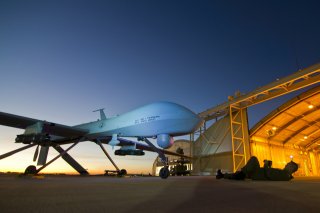Iran Has Really Bad Luck with U.S. Military Drones
Not only are their interceptions unsuccessful, but they can also be down-right embarrassing. Here are two Iranian interdictions that didn’t go as planned.
Way back in 2012, an American General Atomics MQ-1, typically called “Predator” was flying in international airspace, approximately 16 miles from Iran’s coast and conducting surveillance (Iran also flies a Predator knock-off).
Back in those days, drones were more likely to fly without an escort than they are now, and this incident is why.
Two Iranian jets were scrambled and attempted to intercept and shoot down the drone. Using onboard guns, both jets opened fire on the Predator. Although the Iranian pilots conducted several passes, both were unable to hit the drone. The drone was able to return to base untouched.
American officials were subsequently able to identify the aircraft that attempted the intercept. Both were Su-25 Frogfoot bombers, essentially flying tanks. Oddly enough, the Su-25 Frogfoot (yet another example of how heavily Iran leans on foreign tech, particularly for their airframes) is not typically used as an interceptor, but rather for close air support or as a bomber.
In these roles, Su-25 pilots would be unlikely to be particularly efficient air-to-air gunners, having in all likelihood trained on stationary, ground-based targets.
Likely as a consequence of this incident, Predator drones would later fly with a fighter escort, either F-22 or F-18 Hornets. Although this would, in theory, make the drone more easily identifiable to ground-based radar, the extra firepower was deemed necessary.
Another Day, Another . . . Bomber?
Just a year later, another QM-1 Predator was flying on some sort of intelligence-gathering mission near Iran. This time, it came with an escort.
During the mission, two IRIAF (Islamic Republic of Iran Air Force) F-4 Phantoms were scrambled to interdict the drone, apparently unaware that this Predator was accompanied by a lone F-22 Raptor, likely one of the stealthiest aircraft in the world.
The F-22 was able to maneuver Top Gun-like underneath one of the F-4 Phantoms, according to reports,
“He [the Raptor pilot] flew under their aircraft [the F-4s] to check out their weapons load without them knowing that he was there, and then pulled up on their left wing and then called them and said ‘you really ought to go home.’” How embarrassing.
Stealth Is King
Yes, the F-35 Lightning II program has been plagued by cost overruns, production setbacks, and tech hick-ups. The F-22 Raptor is far from perfect. Still, these two incidents demonstrate that stealth platforms, despite the teething issues they’ve had, provide a valuable capability that is worth the investment.
Caleb Larson is a defense writer for the National Interest. He holds a Master of Public Policy and covers U.S. and Russian security, European defense issues, and German politics and culture.
Image: Reuters

